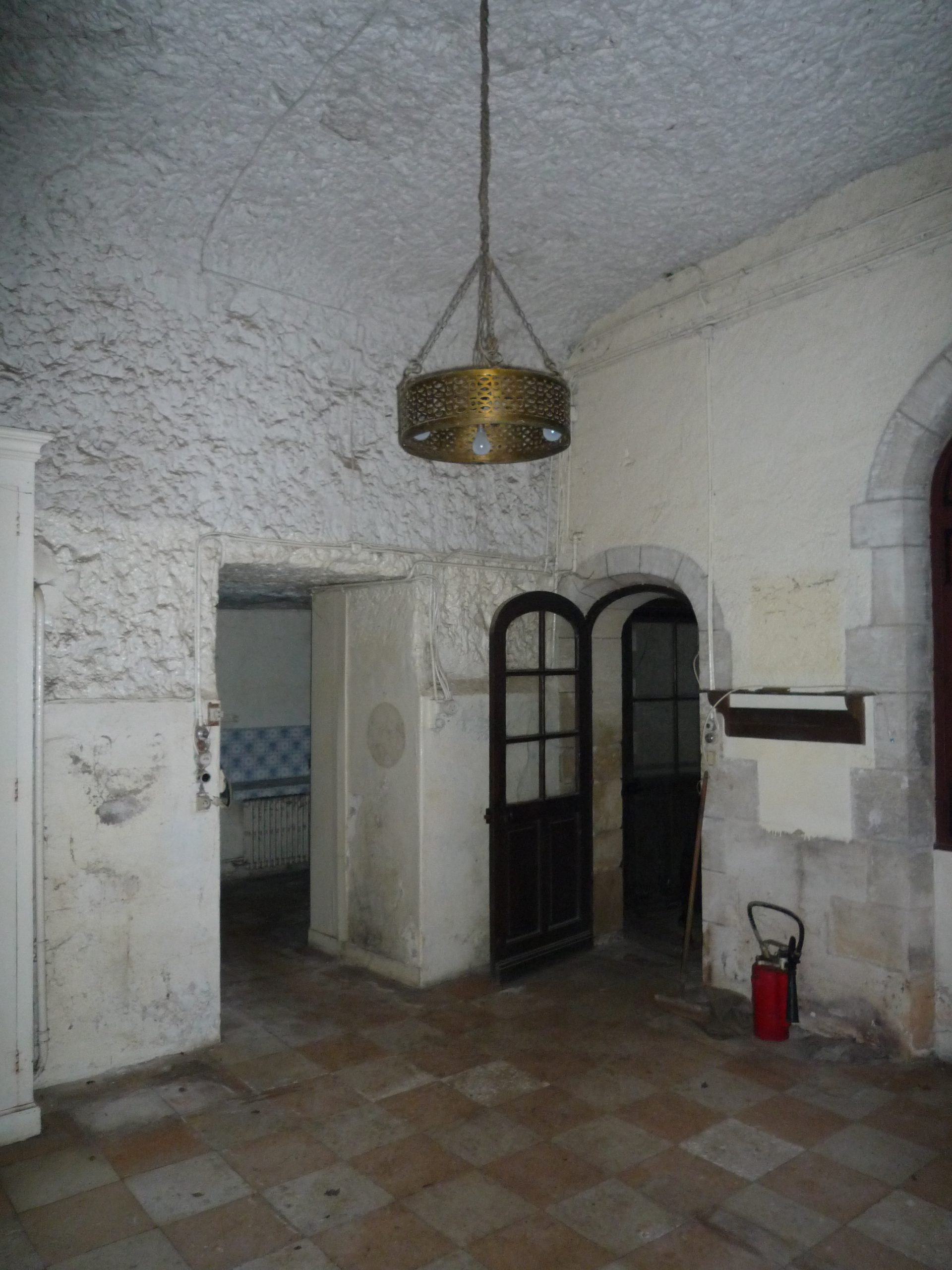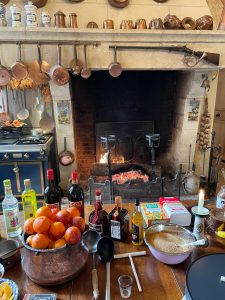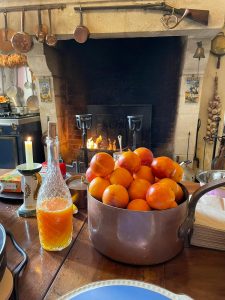la cuisine de la renaissance et du moyen age
Ritual of the Table in the Renaissance
For a long time, it was believed that medieval meals were a collection of dishes placed on the table without rules, but this is a
misconception because there were very particular ways of serving. Public feasts were held on round tables to prevent disputes
and disagreements over seating arrangements.
Until the mid-16th century, there was often only one glass on the table. There were typically two guests per glass, and it had
to be completely emptied before passing it to the neighbor. The glass had to be held with three fingers, raised with one hand,
and emptied in one go. Erasmus even wrote: « The passion for wine causes: black teeth, drooping cheeks, bloodshot eyes,
dulling of intelligence, premature aging. »
On the tables, you would find knives and salt cellars, but no forks. The Renaissance also saw the introduction of two-pronged
forks and table napkins because, all too often before, people ate with their fingers and wiped them on the tablecloth.
Solid foods were eaten with the fingers. Plates did not exist, and soups, sauces, and other liquid dishes were served in bowls
shared by two people. Sometimes, the number of guests was counted in terms of bowls.
Meats or dry and less humid dishes were served on a wooden or metal plate, usually round, called a « tray. » On these trays,
slices of bread, often stale, were placed to absorb the juices – « bread tray. » These trays were never eaten by the guests but
were collected in the alms basket to be distributed to the poor.
In France, the « à la française » style of service emerged, where each « course » or « dish » had a different function and presented
dishes different from the previous one:
1. The first course served as both an aperitif with white hippocras and soaked toasts, and an appetizer consisting of
pies, sausages, and various types of charcuterie.
2. The second course was mainly for heavier meats and soups, including meats and fish in sauce.
3. The third course included roasts, such as small game and roasted poultry.
4. Then came two or three additional courses mainly consisting of birds. The higher one was in the social hierarchy,
the more birds were eaten to be closer to God.
The tasting of these dishes was accompanied by a precise ritual:
• The meal began with the blowing of a horn, the « corner-l’eau, » which signaled the time to wash hands.
• After washing, each guest took their assigned place according to their rank or value.
• Then came the blessing before the arrival of the first dishes.
• A « tasting » was then conducted. Before being tasted, each dish had to be sampled, both out of fear of poison and to
adapt it to the prince’s taste, as with wine. This is why dishes and goblets arrived covered from the kitchen.
• The fear of poison is also reflected in the practice of not tasting food or drinks but touching them with a supposed
talisman to detect any trace of poison: the unicorn horn, actually a piece of rhinoceros horn, or the snake’s tongue,
actually a piece of shark tooth. The latter was specifically used for the salt test and remained attached to the salt
cellar by a chain.
• Between each course or dish, a simple « entremets » was presented, which differs from the grand spectacle
« entremets » served at large banquets.
• The dessert, consisting of compotes and fruits, arrived towards the end of the meal, followed by red hippocras
accompanied by wafer-like delicacies.
• Then, grace was recited, hands were washed again, and the tables were cleared and dismantled. The « Mesnagier » (a
household and culinary manual) provides a recipe for handwashing water: « To make handwashing water at the
table, boil sage, then strain the water and let it cool until lukewarm. Or you can add chamomile, marjoram, or
rosemary, and boil it with orange peel. Laurel leaves are also good. »
• Guests were then offered the « boute-hors, » composed of wine and spices, which can be compared to our digestifs,
coffee, and after-dinner drinks (eaux-de-vie were already well-known in the 13th century under names like « eaux
d’or, » « eaux de vin, » « eaux ardentes, » or « éternelles »).
• At court, there was a particular custom of serving spices in a « drageoir. » Presenting the « drageoir » was an honor
reserved for a distinguished person. The first chamberlain would pass it to the most important guest, who would
then offer it to the Duke.
Example of a typical souper:
• First course: Capon with herbs, peas, and wine soups.
• Second course: The best roast available in jelly with sweet cream.
• Third course: Capon pies with a cold sage sauce, stuffed lamb shoulder, wild boar tail, and crayfish.
Example of a typical dinner:
• First course: Cooked apples, large roasted figs from Provence with laurel leaves on top, watercress with vinegar,
peas, salted eels, white herring, and fried seafood from both sea and freshwater.
• Second course: Carp, sole, red mullet, salmon, and eels.
Afterward: Figs, grapes, hippocras, and « mestriers » (rolled wafers)
Cuisine troglodyte XVII ème
Nestled 25 meters beneath the hillside, it consists of four parts: an office, a dining kitchen, a laundry, and a butcher’s area. It
features a large stone fireplace with a bayonet joint lintel, and the chimney, hand-dug, measures 1 meter wide by 25 meters
high. You can see the different layers of flint on the vault, which comes from the ancient Sea of Faluns (dating from the
Miocene, which filled a Loire Gulf between 11 and 16 million years ago).
The floor consists of antique floor tiles, 4 cm thick.
The central table, made of light oak with crossbars, has a clever system of extensions stored inside and can accommodate up
to 24 guests. The antique cabinet is colorful and painted with bitumen of Judea (blue-green, used as glaze in the Italian
Renaissance). Traces of it can be found in Leonardo da Vinci’s painting « The Virgin of the Rocks. » It is also painted with red
ochre, rare and used as a pigment, also known as Prussian Red, Antwerp Red, or Dutch Red. It features the ermine of Anne of
Brittany and the royal fleur-de-lis. Children drank beer because the water was impure for consumption. The higher one was
in the social hierarchy, the more birds were eaten to be closer to God. Meat was boiled, and aromatic herbs were used in
cooking. Wine was mixed with spices and honey (sage wine, hippocras wine, etc.) to mask its bitterness.
The Renaissance
also saw the introduction of two-pronged forks and table napkins because, all too often before, people ate with their fingers
and wiped them on the tablecloth. Public feasts were held on round tables, a means to prevent disputes and disagreements
over seating arrangements. Until the mid-16th century, there was often only one glass on the table. There were typically two
guests per glass, and it had to be completely emptied before passing it to the neighbor. The glass had to be held with three
fingers, raised with one hand, and emptied in one go. Erasmus wrote: « The passion for wine causes: black teeth, drooping
cheeks, bloodshot eyes, dulling of intelligence, premature aging. » On the tables, you would find knives and salt cellars, but
no forks. Solid foods were eaten with the fingers. Plates did not exist, and soups, sauces, and other liquid dishes were served
in bowls that were shared by two people. The « Mesnagier » (household and culinary manual) provides a recipe for
handwashing water: « To make handwashing water at the table, boil sage, then strain the water and let it cool until lukewarm.
Or you can add chamomile, marjoram, or rosemary, and boil it with orange peel. Laurel leaves are also good. »




